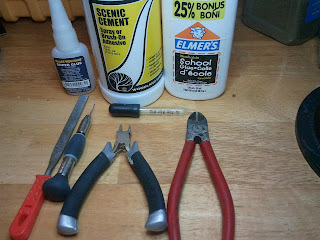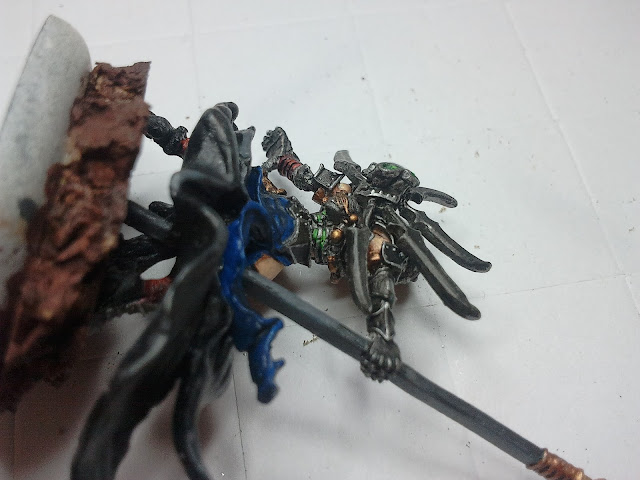The first thing to consider above all is the theme for your army if you have one. Does your army come from the snowy north? Are they desert nomads? Do They live on a hot Mercury type planet, alien hive world, swampy jungle, or subterranean dwelling? Where your army originates in a game world matters if you really want to make your miniatures stand out or fit in with the story lines and histories of the game. I have chosen to to base my Cryx army in a rocky forest to fit in with the story arc between Cryx and Khador, which my buddy is playing. I also chose this because it will match the playing surface of my gaming table.
Which is the next thing you should consider. Where do you play games the most and what does the playing surface look like? If you just play on a bare kitchen table on a regular basis then you can do whatever you like (which you can anyway, who cares right?). You may play at a local club or GW store where there are many different types or landscapes. In this case pick one you like and go with that. If you are primarily into painting miniatures like I am, and only find playing the game a bonus to the hobby of painting, then it is best to just pick a theme for the army you are painting and build bases around that.
Tools you need:
Cork Tiles: I got these from the stationary section at Walmart next to the push pin boards/bulletin board. It came in a 4 pack for $9 dollars. You can get them in different sizes from Michael's but they want $19 dollars for a 4 pack here in Canada which is ridiculous. These are roughly 3mm thick, they are the second smallest size you can get from Michael's, they only had one size at Walmart
Super Glue: Any super glue will work. I like GW Superglue because you get a lot for $10 dollars.
Scenic Cement: You can get this from local hobby shops, and places that sell model trains and railroad accessories and is made by "Woodland Scenics." It is a watered down glue mixture that dries clear and hard. It can be sprayed from a spray bottle or dripped into place with an eyedropper.
White Glue: Any White glue will do.
Eye Dropper: To apply the Scenic Cement.
Flat File: To file flat the bottoms of the feet or area you are going to pin.
Pin Vise: For pinning minis to the base.
Wire Cutters: For Cutting the paper clips and trimming off big areas of the metal tabs attached to the feet of the model.
Modeling Clippers:
Paper Clip: The Pins.
Ballast: Rock texture of different sizes from Woodland Scenics.
Talus: Debris and river rock/ bedrock from Woodland Scenics.
Fine turf: Colored sawdust, great for creating dirt, filling space, moss, base for static grass.
Figure out how you want the cork to sit on your mini and try to cover the hole that is in slotted bases, like the one shown above. Once you have it in position place superglue on the parts of the cork the will make contact with the base leaving a space where the slot is.
Next you want to carefully cut the tab off the bottom of the feet with wire cutters, making sure not to cut too close to feet or cut off any details on the model.
Make two cuts first first, one under the foot, and another through the middle of the tab. Be careful when cutting through the metal because it will bend the legs a little bit. Once these cuts are made make another vertical cut, the same way you cut the middle, right net to the heel of the foot. This will cause all the little pieces to fall off. Do not pull the metal parts hanging from where you just cut through the metal, this will bend the mini and maybe even snap a leg off.
Now that the metal tab is off, you can clean up the bottoms of the feet with model snips.
File away any lines or uneven sections with a flat file. File until the bottom of the foot is flat. Now very slowly and carefully bend the legs into place and test standing the model on the cork base. keep lightly readjusting the feet until the mini will stand on the cork base by itself. Once you know the model is standing balanced on the base you can pin it if possible before gluing it down to the base, or you can just put a little bit of super glue on the bottoms of the feet and attach it.
Now that the minis are free of their tabs and glued down to the bases it's time to texture around the cork with rocks and debris. The type of look you are going for will determine the materials you use. I am going for a rocky forest theme for my bases. To texture for this effect I use 4 tbs of "Fine Brown Ballast" and 2 tbs of "Medium Brown Ballast." Mix these together in a small shallow container. You could use those little dishes that you put dipping sauce in, applesauce cups or anything else you can find that will fit the circumference of the base and allow you to push the model down into it. Applesauce cups work best due to low cost.
Once the ballast is mixed up I add 2 tbs of "Fine Turf: Earth" and 1 tbs of "Talus: Fine Brown Debris." You can get all of these products from hobby stores and is made by "Woodland Scenics".
When it is all said and done it should look something like this!
Paint white glue onto the base around the cork with an old paintbrush. Go all the way around the cork and fill any holes that may have been made with glue. You don't need to use very much glue, just a small drop on each section that will need glue, and spread it around with the paint brush.
Next, dip the mini into the textured mixture making sure it covers all the areas with glue. Let it sit for a second and then pull it out. Push down on the sand all the way around the base to ensure the rocks are secured in the glue then tip the excess back into the mixture. Give the bottom of the base a few taps to ensure you get it all off and then place it to the side to dry. Continue doing this with all the minis you have based, and let them dry for about an hour.
Once the rock texture has dried it's time to go back over all of the mini's again with "Scenic Cement." Pour a little in the cap of the bottle and use an eyedropper to draw some out. place one drop onto the ballast mixture and watch how the scenic cement fills the cracks between the ballast. Once the water stops spreading place another drop next to it, and with for it to spread, continue all the way around trying not to saturate the rocks too much with the scenic cement. It seems like a process but it literally takes a millisecond for the scenic cement to fill the ballast. You may be asking why I am using two glues to fix the texture to the base. Well the simple answer to this is that I want to ensure the rocks are fixed in as one solid sheet of glue and rock, and it will also stop little pebbles from breaking loose as I apply a diluted paint to it when I get to the painting stage.
I have dropped models before and had the ballast peel off in a small sheet that could be easily re-glued to the surface of the base, rather than have small rocks flake off continuously till the base looks patchy. I highly recommend scenic cement for bases and terrain making. A bottle will go a long way on mini's, two bottles allowed me to secure rocks to a 6'x4' foot table out or a spray bottle so don't be turned away by the $8 dollar price tag.
Once it is all dry you can use what ever colors you had in mind, and use the dry brushing technique to give the rocks some depth and dimension. Use your brightest color only on the edges of the cork to give it a lighting effect and you will be done. Add some sort of static grass or "Underbrush" from woodland scenics for the foliage and you can also line the base of the cork with green or brown"Fine Turf" to create moss or erosion.If you have heads, arms, legs, torsos, hands, etc laying around a bits bow, you could also add these to the base and paint them all gored up. You could even use the sprue you cut your minis off of to make crystals, logs, steel beams, etc. I reuse and recycle anything that i think will look good in a mini.
I was considering a alien hive world theme for Tyranids (before the price raises at GW), and broke open a bunch of old "Britta" filters. The rocks and minerals used in the filtration process are really weird looking and when you let the contents of the filter dry in the sun it creates these little transparent, green/yellow balls about the size of pin head or smaller. You could just apply this in its raw form to give the minis a very unique base without having to do any painting.
Next up: My last step by step tutorial for painting. After this one you should have an idea about how I go about painting mini's and in the future I will just put up pics or works in progress, and discuss anything I did differently from one set of minis to the next.
I have also just received my first painting commission! I will be taking a break from my own army to focus on this commission for the Khador Army. I will be posting regularly with updates on the progress and give a few small tutorials through out the process on painting and shading red hue's on a mini, as well as my thoughts on "P3" paints by Privateer Press!

































































